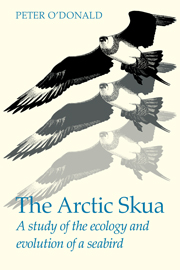Book contents
- Frontmatter
- Contents
- List of figures
- List of tables
- Preface
- 1 The Arctic Skuas of Fair Isle
- 2 Numbers and distribution
- 3 Feeding behaviour and ecology
- 4 Breeding ecology
- 5 Genetics
- 6 Demography and selection
- 7 Sexual behaviour
- 8 Sexual selection
- 9 Genetic models of sexual selection in birds
- 10 Mating preferences of the Arctic Skua
- 11 Conclusions
- Appendix A Rates of increase of bird populations
- Appendix B Analysis of variance of a 2 × r table with unequal numbers of observations
- Appendix C Statistical analysis of assortative and disassortative mating in polymorphic birds
- References
- Index
7 - Sexual behaviour
Published online by Cambridge University Press: 21 May 2010
- Frontmatter
- Contents
- List of figures
- List of tables
- Preface
- 1 The Arctic Skuas of Fair Isle
- 2 Numbers and distribution
- 3 Feeding behaviour and ecology
- 4 Breeding ecology
- 5 Genetics
- 6 Demography and selection
- 7 Sexual behaviour
- 8 Sexual selection
- 9 Genetic models of sexual selection in birds
- 10 Mating preferences of the Arctic Skua
- 11 Conclusions
- Appendix A Rates of increase of bird populations
- Appendix B Analysis of variance of a 2 × r table with unequal numbers of observations
- Appendix C Statistical analysis of assortative and disassortative mating in polymorphic birds
- References
- Index
Summary
Territoriality, pair formation and mating behaviour
Observation of a few pairs of Arctic Skuas may reveal only very little of their courtship and mating behaviour. Pairs often copulate with no obvious preliminary courtship; they may have bred together for many years. Birds that know each other well enough perhaps have no need for elaborate courtship.
Perdeck (1963) observed the pairing of a few single birds and the mating behaviour of some established pairs in a colony of Arctic Skuas on the Faeroe island of Mykines. Since the birds had not been ringed, pairs from previous years could not have been distinguished from newly formed pairs. Single birds in the act of pairing may simply have been rejoining their former mates. If they had been seeking new mates, their behaviour might have been different. A detailed analysis of pairing and mating behaviour would have been possible on Fair Isle where all birds from previous years are known by their colour rings. But my own study of the population biology of the Fair Isle Arctic Skuas never allowed time for systematic observations of behaviour. Of course, I observed many aspects of their agonistic, pairing and mating behaviour. My own observations of their calls and postures agree closely with those of Perdeck, whose terminology I have used in the following account.
Agonistic behaviour in defence of territory
Perdeck (1963) observed the agonistic behaviour of Arctic Skuas defending their territories.
- Type
- Chapter
- Information
- The Arctic SkuaA study of the ecology and evolution of a seabird, pp. 145 - 179Publisher: Cambridge University PressPrint publication year: 1983



